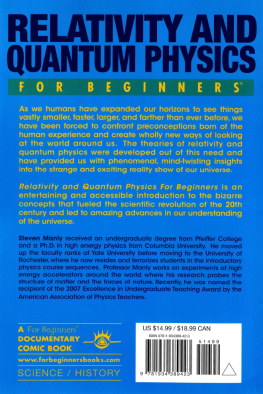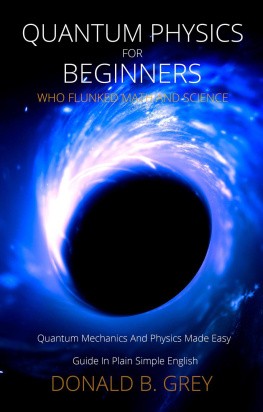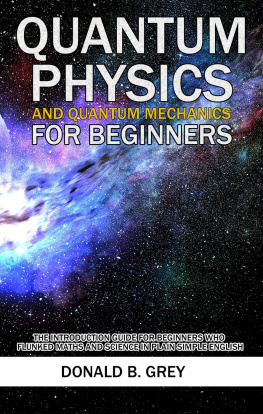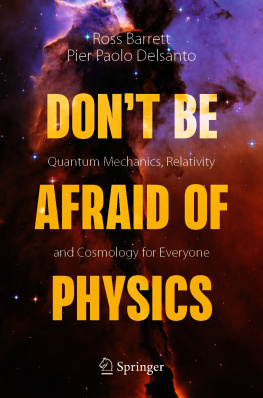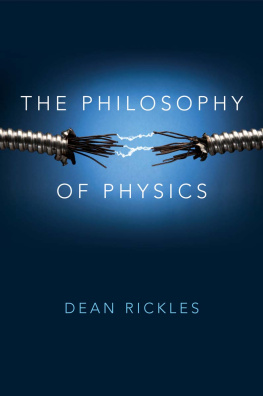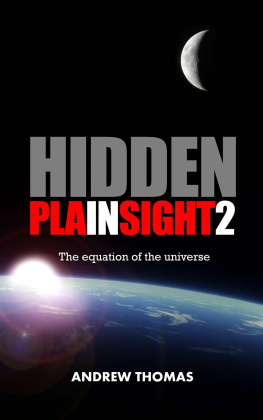HIDDEN IN PLAIN SIGHT
Andrew Thomas studied physics in the James Clerk Maxwell Building in Edinburgh University, and received his doctorate from Swansea University in 1992.
He is the author of the What Is Reality? website (www.whatisreality.co.uk), one of the most popular websites dealing with questions of the fundamentals of physics. It has been called "The best online introduction to quantum theory".

HIDDEN IN PLAIN SIGHT
Copyright 2012 Andrew D.H. Thomas
All rights reserved.
DEDICATION
To Mum and Dad
CONTENTS
PREFACE
For the last seven years I have been running a website on fundamental physics (www.whatisreality.co.uk). I am pleased to say that over that period the website has grown to become one of the most popular physics sites on the web.
The seven years working on the site have provided me with the opportunity to consider some of the most challenging questions about fundamental reality. Some avenues which initially appeared promising turned out to be blind alleys, while other seemingly innocuous principles turned out to be surprisingly fruitful. This book presents some of the most important insights I gained over those seven years.
I am pleased to say the website has gained high praise from some of the most famous names in physics, but I have been more heartened by some of the comments left by casual visitors to my site, especially those who have appreciated the site and felt I managed to make physics exciting, entertaining, and easy to understand. Hopefully this book can continue that trend.
Andrew Thomas
(hiddeninplainsightbook@gmail.com)
Swansea, UK
2012

UNIFICATION
In our modern world, we have grown used to ever-increasing complexity. We perpetually have to upgrade our mobile phones to the latest version 5.0 with new features we never knew we wanted. We have to buy the latest television with hard-disk recording built-in, and a baffling remote control to match. It feels like it is just a matter of time before the internet becomes so complicated that it develops self-awareness, calls itself "SkyNet", and launches a thermonuclear war against humanity.
Complexity is seen as a virtue, a selling-point. Extra features are seen as a good thing. Are you not confused enough yet?
I want to strip my life back to simplicity. I have cancelled my Facebook account. I have organised my apartment, stripped it down to the basics and discarded all unwanted junk. By removing distractions, I hope it is going to allow me to concentrate. When you feel the complexities of life are getting you down, you have to strip your life back to simplicity.
We tend to think of simple things as more beautiful. They are more economical, with less waste, less superfluous clutter. If we clear our heads, we can see things more clearly. If we clear our heads, we can see the truth.
Nature also likes simplicity. Nature abhors waste, both in materials and in energy. Everything in Nature is done for a good reason. We see beauty in simplicity because we can see its underlying efficiency. We might recoil from seeing an ostentatious sofa because so much of its covering serves no purpose, the inefficiency of its design being antithetical to the beauty of Nature. However, when we see a sleek, lean, minimally designed chair we are instantly attracted to its spartan beauty (perhaps until we have to sit on it for a couple of hours).
Due to Nature's close affinity with simplicity, the advance of fundamental physics over the centuries could be seen very much as the pursuit of simplicity. As physics has progressed it has been found that more elegant, simpler theories have been found to be the best match for reality. It is very important to remember this when we do physics: ask yourself, are you making things simpler? If not, then think again. As Albert Einstein said: "Any intelligent fool can make things bigger and more complex. It takes a touch of genius and a lot of courage to move in the opposite direction."
In physics, one of the most successful ways of simplifying our explanations has been by reducing redundancy in those explanations. If we find we have two theories which explain two apparently different behaviours of Nature, we might find it possible to replace both those theories with a single theory which still manages to explain both of those behaviours. When this happens, the process is called unification. The resultant unified theory will be simpler than either of the two previous theories, as it reveals a deeper, underlying truth.
This process of unification always represents a landmark in physics. It is like drawing a line in the sand. It shows we have reached a new level of understanding we will never have to go back to our previous level of ignorance. Unification is, in many ways, the ultimate goal of physics. If physics is ever to provide a complete understanding of the universe, then the last act which will be performed by the very final physicist will be an act of unification.
This book has a single goal, though it is highly ambitious. The aim of this book is to reveal a link possibly a unification between relativity and quantum mechanics at the deepest possible level: the fundamental level. This link is based on an extremely simple principle, a simple idea.
Simplicity is good. I like simplicity.
What unifies unifications?
As we start out on our quest, a good starting point might be to examine some of the major unifications in the history of physics. Maybe we can detect trends or similarities in their approach. Maybe we could adopt aspects of their approaches to aid our quest. With this in mind, what follows is an historical review of some of the major unifications in physics. Don't worry too much about following the details any principles which are important for our discussion will be described in detail later in the book. For the time being, just get a feel for the history of unification.
We start in 1638 when Galileo, the man described as the father of modern science, published his Discourse on Two New Sciences. Galileo realised that if you are travelling at a constant speed in a constant direction (for example, being a passenger on a steady train), you feel as if you are stationary. Galileo had the insight that it was fundamentally impossible to distinguish the two situations of moving and being stationary. To be precise, Galileo stated that there was no experiment you could possibly perform which could detect if you were stationary or moving at a constant velocity. This unification of "being stationary" and "moving" stands as the first of the great unifications in physics.
In 1665, a 22-year-old Isaac Newton wondered if the force which pulled apples from a tree was the same force which held planets in orbit. Again, we see a simple, brilliant insight, an imaginative leap. From Newton's clear vision, a description of the force of gravity emerged as the unifying theory for two behaviours which were previously considered to be unrelated.
Another unification occurred in the nineteenth century by the man widely acknowledged to have been the greatest experimental physicist of all time. In 1831, at London's Royal Institution, Michael Faraday demonstrated that if you push a magnet through a coil of wire, an electric current flows. Conversely, if you pass an electric current through a wire it can deflect a nearby magnetic compass. From this, Faraday deduced that electric currents create magnetic fields, and moving magnetic fields create electric currents. Thus was




